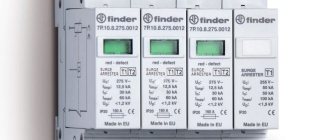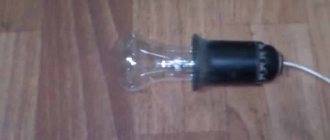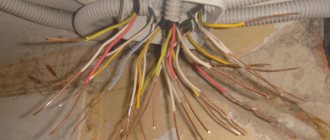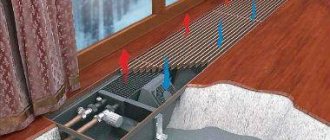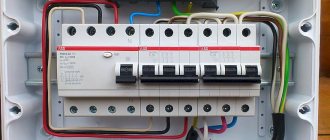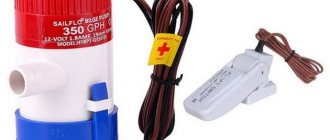What is lightning?
Many owners of private houses try to make their home as comfortable and safe as possible, but at the same time they forget about the possibility of their home being struck by lightning.
Lightning is one of the most unpleasant phenomena that can cause enormous damage to a home.
As you know, it is a high-power electrical discharge, so even if it enters the house indirectly, it can damage electrical equipment in the premises.
It is good if there is a tall building near the house, equipped with lightning protection.
In this case, you don’t have to worry about the possibility of lightning striking your house, since such houses often have lightning rods with a large protection zone, which will cover the area with adjacent buildings.
A special feature of lightning is the discharge to the highest point. Therefore, if a house is located on the outskirts, it is the highest point, unless, of course, a tree grows next to it that is taller than the house.
But wood is also not a guarantee of protection. The risk of a home being struck by lightning increases many times over if there are ponds, strong streams, or swampy areas near the house.
So, if a private house is not surrounded by high-rise buildings, it is better to protect yourself by providing your home with lightning protection.
Main types of lightning rods
Lightning protection of a wooden structure occurs thanks to lightning rods. All lightning rods that you can find on sale are divided into two types:
- Singles.
- Cable.
More information about installing a lightning rod.
Cable wires are a system of cables that must be pulled between single lightning rods. In domestic cases, they provide reliable protection of areas over a large area.
The general lightning protection system includes three elements:
- Ground electrode.
- Down conductor.
- Lightning rod.
You should not carry out lightning protection of a private home yourself. This requires appropriate experience and knowledge.
Damaging factors of lightning
But before you figure out how to protect your home from possible lightning damage, you should consider the damaging factors of this phenomenon.
There are two of these factors.
Primary.
This is a direct lightning strike on a house, as a result of which it may suffer structural damage and there is the possibility of a fire. This factor is the most dangerous.
Secondary.
Less dangerous for the home and residents. This factor comes down to the appearance of electromagnetic induction in the wiring of the house during a lightning discharge near the house.
Due to induction, a significant voltage surge occurs in the wiring, which can damage all electrical appliances in the house connected to the network.
And if you can protect yourself from the secondary factor without additional equipment by disconnecting all devices from the network during a thunderstorm, then it is impossible to protect yourself from the primary factor in this way; you need to equip your house with lightning protection.
Ohio, a house struck by lightning.
Since lightning is just an electrical discharge, albeit of great strength, it acts like any other discharge, that is, it moves along the path of least resistance.
Providing this path is the task of lightning protection.
If lightning strikes a house equipped with this type of protection, the electrical discharge will go into the ground without causing damage to the building.
Popularly, such protection is called house grounding, lightning rods, lightning rods.
As for the latter, the definition is not entirely correct, because thunder is just the sound that occurs during a lightning discharge.
Type selection
The type of lightning protection planned depends on the initial state of the house and the conditions in which it is located. Lightning usually strikes the highest point of the house or a nearby tree. When struck by lightning, trees, antennas, and poles create a screen effect and neighboring buildings and cars can fall into the affected area.
The second condition when installing protection is the type of soil , different types of which have different conductivity and resistance, which is taken into account when choosing the cross-section of the metal strip and the depth of the contour.
If your house is near a pond or springs, then the risk of being struck by a discharge is maximum, especially if, according to climatic conditions, the number of thunderstorm periods exceeds 40 hours per year.
How to choose the right parquet board? You will find the answer to this question here. And here is an article about installing grounding for your home.
Criteria and types of lightning protection
Now let's look at the types of lightning protection.
Here, this equipment has several criteria that divide it into types.
The first criterion is the method of protection.
According to it, lightning rods are divided into:
- Active;
- Passive.
The active ones appeared relatively recently. They contain a lightning rod, discussed below, equipped with a special ionizer, which “provokes” lightning with its impulses.
The need for lightning protection devices for wooden buildings
Current construction standards and rules also require the mandatory implementation of a system such as lightning protection for a private wooden house. In particular, current SNiPs classify such buildings as third class in terms of the level of required fire safety. That is why a lightning rod must be provided at the design stage of a residential building.
This requirement does not mean that lightning protection cannot be done by hand. On the contrary, in the vast majority of cases during individual construction, such work is carried out directly by the future owner. This is explained by the fact that a lightning rod is, as a rule, a fairly simple system in design and technology that deserves a more detailed description.
Lightning protection design
Now regarding the design of lightning protection, let’s talk only about the external one for now.
It consists of only three elements - an lightning rod, down conductors and a grounding conductor.
Lightning rod.
It receives a lightning strike, so it is fixed on the roof of the house so that the receiver itself is the highest point.
The simplest is the rod type of receiver.
A metal rod with a diameter of 10-18 mm and a length of 250 mm is considered standard.
You can also use a pipe, but only its ends must be welded.
The number of receivers is calculated based on the size of the building. For small houses, one is enough, but if the area of the house exceeds 200 square meters. two rods are installed with a distance between them of 10 m.
To prevent the discharge from the receiver from reaching the house, it is secured to the roof using wooden blocks or special fasteners.
Some, in order not to spoil the appearance of the house, install the lightning rod on a separate support near the house.
Some, if possible, attach an additional lightning rod directly to the tree.
There is not much difference, since even with a lightning rod installed nearby, the protection zone will cover the house.
The main condition for installing the receiver is that it must be located above the house, as well as other buildings near it.
Another type of lightning rod is a cable one.
A cable is used that is stretched along the entire length of the roof ridge and secured to wooden supports. An important condition is the tension of the cable - it should not touch the roof.
The third type of receiver is the mesh.
It is made from any wire (steel, aluminum, etc.) with a cross-section of at least 6 mm.
It is stretched over the entire roof area; the cells of this mesh should form a square of approximately 6x6 m.
In this case, the mesh should also not touch the roof; it is fixed on wooden or special non-conducting supports at a height of 6-8 cm from the roof.
There are no strict regulations for the use of this or that type of lightning rod; you can use any, they are all quite effective, so they are chosen at will.
Down conductors.
Next, let's talk about the second element of this protection - down conductors.
Their main task is to transfer the discharge from the receiver to the ground electrode.
Most often, steel wire with a diameter of 6 mm or more is used as down conductors.
If the walls of the house are made of brick or foam block, in general, of any non-flammable material, then the down conductor can be secured along the wall in any inconspicuous place, most importantly, not near windows and entrance doors.
You can also use metal tape as a down conductor, but it must be at least 2 mm thick and 30 mm wide.
The down conductor is attached to the receiver using a welded, bolted or soldered joint.
The number of down conductors depends on the number of ends of lightning rods.
If only one rod receiver is used, then one bend is attached to it. When using a cable receiver, two taps are already needed.
Also, two down conductors are used for a grid receiver.
Ground electrode.
The last element is the ground electrode. The simplest grounding device is two metal rods buried 2-3 m into the ground.
The distance between them must be at least 3 m. These rods must be connected to each other with a jumper at a level of 0.5-0.8 m in the ground. The down conductor is connected to this jumper.
On soils with a high groundwater level, it is better to use a horizontal position of the ground electrode at a depth of 0.8 m. In this case, the ground electrode should be a metal corner or strip with a width of 50 mm and a thickness of 4 mm.
The ground electrode is connected to the down conductor only by welding.
Read on the topic - protecting electrical appliances using special devices.
The principle of operation of internal lightning protection of a house
It is difficult to imagine life today without electronic and household electrical devices and appliances. All this equipment is connected to the power grid, and cables also go from the computer and TV to the local network and satellite dish.
Data transmission lines through receivers, servers, distribution devices, power lines are subject to lightning strikes and the influence of electromagnetic fields. Under certain circumstances, high voltage and high current move through the cables to a low potential, i.e. TV, refrigerator, computer. The result may be failure of electrical appliances, fire, or threat to human life.
To protect yourself and your home, you need an internal lightning protection device for a private home or surge protection.
This protection operates simply - it instantly equalizes the potentials between the electrical conductors. This task is performed by an SPD - a special surge protection device.
Installation of this device is possible only after installing reliable external protection. To implement a lightning protection system for a private home, a project is being developed that takes into account all the ways to enter a high-voltage building.
After installing the SPD, non-current-carrying elements are connected to the grounding bus, and lines that cannot be grounded are connected to the bus through the SPD.
To select an SPD device, there are rules that can be divided into groups depending on:
- Indicators of the protected network - current, voltage, frequency, wire cross-section;
- Network type – power supply, cable TV, telephone line, alarm system, etc.;
- The significance of the protected object - PC, TV or bank server.
Features of lightning protection installation
Based on what has been described, you can understand that it is quite possible to make lightning protection yourself, having only the necessary materials.
To protect your home from lightning, you must first take measurements.
It is necessary to find out the height at which the receiver should be located, and also determine the method of its mounting.
Then you need to calculate the length of the down conductor. It is important to consider here that the lightning charge path to the ground electrode should be as short as possible. Therefore, you should not make any contours, bends, etc. And even more so, it is impossible to form rings from the tap.
As for the ground electrode, it must be located at least 1 m from the nearest wall of the house. After all the calculations, you can begin installation.
You need to start with the ground electrode.
If it is made of rods, it is enough to dig a trench 0.5 m deep and 3 m long.
Drive rods at least 2 m long into the ground along the edges of this trench.
Then, using a welding machine, weld a jumper to these rods.
If the ground electrode is horizontal, then you will have to dig a trench much deeper.
Next, you can proceed to installing the receiver.
An important condition must be observed here - it should not come into contact with the roof of the house, so only wooden supports should be used to secure it.
Or you need to attach it directly to non-conductive structures of the house.
Then a down conductor is attached to the receiver and grounding conductor, which can then be attached to the roof with special devices, and then to the wall of the house.
The down conductor can be secured to the receiver using bolts, but to the ground electrode - only by soldering or welding.
All that remains is to bury the pre-dug trench.
As for installing protection on a house with wooden walls, the principle is identical, but there is one condition - you cannot attach down conductors directly to the wall.
They must be located at least 150 mm away from the wall.
Comprehensive lightning protection according to an individual project
cooperates with the only distributor of Polish in the Russian Federation, which is a leading enterprise in Europe in the field of lightning protection and complex grounding.
The turnkey security complex is:
- on-site consultation with a specialist;
- system design;
- selection of high-quality components of European quality with anti-corrosion coating and improved insulation;
- budgeting;
- installation of the entire complex;
- commissioning works.
We have a large selection of different types of parts in stock. When exclusive elements are used in a project, they are delivered from Poland in the shortest possible time. All products are sold at manufacturer prices.


